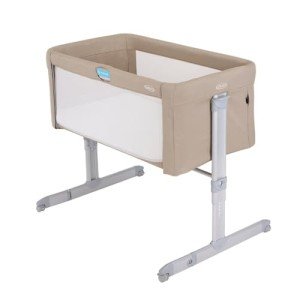20 Questions You Need To Ask About Bedside Cot For Co-Sleeping Before You Purchase Bedside Cot For Co-Sleeping
The Benefits and Considerations of Bedside Cots for Co-Sleeping
Co-sleeping has actually become a popular choice for numerous new parents who look for to keep close proximity to their infants throughout the night. Along with you can try this out -sleeping practices, bedside cots are getting traction as an option that offers both the comfort of closeness and the safety of separate sleeping spaces. Bedside Crib For Babies intends to explore the principle of bedside cots for co-sleeping, highlighting their benefits, potential drawbacks, pointers for selection, and common issues.
Comprehending Bedside Cots
Bedside cots, also referred to as side-sleepers or co-sleepers, are specially created cribs that are attached to the side of the parents' bed. They enable parents to keep easy access to their infants during the night while offering a different sleeping location that can enhance safety and comfort.
Features of Bedside Cots
- Size and Design: Bedside cots are typically smaller sized than standard cribs however still provide ample room for an infant. Most designs have adjustable heights to match the bed.
- Side Panels: Many designs include removable or mesh side panels that enable for safe visual tracking of the baby, enhancing parents' capability to react to their baby's requirements rapidly.
- Stability and Safety: Bedside cots are developed with stability in mind, featuring safety anchors or straps that secure the cot to the parent's bed.
- Alleviate of Access: Parents can quickly reach over to comfort or feed their baby without having to get out of bed, assisting in nighttime breastfeeding or soothing.
Benefits of Using Bedside Cots for Co-Sleeping
- Improved Bonding: Proximity to the baby cultivates emotional connection and bonding, which is essential during the early stages of advancement.
- Easier Nighttime Care: Nighttime feeding and soothing become significantly much easier with a bedside cot, as parents can simply lean over to participate in to their baby's requirements.
- Increased Safety: Bedside cots minimize the risk of suffocation or accidental rolls that can happen with standard co-sleeping straight in the parental bed.
- Individual Sleep Space: The documentation supports that having their own sleeping space can assist infants sleep better in regards to less disturbances from parents.
- Transitioning: A bedside cot can be a useful transitional tool as babies grow and begin to transfer to their own rooms.
Function
Benefits
Enhanced Bonding
Closer physical presence
Easier Access
Quick action to requirements
Increased Safety
Decreased risk of accidents
Private Space
Less disruption during the night
Streamlined Transition
Simpler relocate to independent sleeping
Factors to consider Before Choosing a Bedside Cot
While bedside cots offer various advantages, possible users should think about the list below elements:
- Size of Bed: Ensure that the cot fits surrounding to the bed without causing discomfort or overcrowding.
- Budget: Prices can differ considerably among various brands and models, so consider budget plan constraints thoroughly.
- Security Standards: Check that the cot satisfies all safety guidelines to ensure it is free from hazardous products and includes necessary safety functions.
- Material: Non-toxic finishes and materials are crucially essential for infant health.
- Infant's Age and Weight: Some cots have weight limitations, and parents must choose accordingly based upon their baby's growth.
Tips for Selecting a Bedside Cot
- Read Reviews: Look for user feedback and security scores.
- Look for Certifications: Ensure the cot complies with security requirements.
- Inspect the Design: Choose a design that matches your bedroom style while ensuring functionality.
- Consider Accessibility: Look for designs that permit easy reach but reduce the threat of presenting.
- Test Stability: Ensure that the cot is steady and safe when connected to the bed.
Common FAQs About Bedside Cots for Co-Sleeping
Q1: Are bedside cots safe for co-sleeping?
A1: When used properly, bedside cots are developed to supply a safe sleeping alternative for infants while allowing close proximity to parents. Constantly make sure to protect the cot appropriately to avoid motions that could lead to mishaps.
Q2: At what age can I begin utilizing a bedside cot?A2: Many parents begin utilizing bedside cots right after the baby is born. However, it is necessary to talk to a health care service provider regarding your infant's preparedness for co-sleeping, particularly if they were born too soon. Q3: Can I use a regular
**crib for co-sleeping? A3: While routine cribs can be used, they do not offer the very same level of ease of access and security as bedside cots, making bedside choices more beneficial for co-sleeping. Q4: What if my baby rolls over?A4: Most bedside cots are designed with security features that lessen risks if a baby rolls. In addition,
they are generally low enough that a roll would not result in a significant drop. Q5: How do I transition my baby from a bedside cot to a regular crib?A5: Gradually move your baby to a different crib in their own room after they end up being familiar with sleeping in the bedside cot. Start with Side Sleeping Crib in the crib while keeping nighttime co-sleeping until they adjust. Bedside cots provide a useful and much safer alternative to direct co-sleeping, supplying various advantages in terms of convenience and security. They facilitate bonding
in between infants and parents while reducing the threats associated with standard co-sleeping practices. Parents looking for a way to keep their babies close at night should think about the benefits that bedside cots can provide. With a careful examination of alternatives available, parents can create a safe and comfortable sleep environment that supports their household's special requirements.  **
**